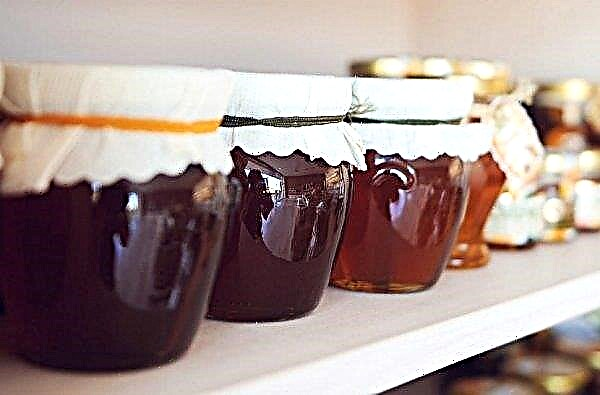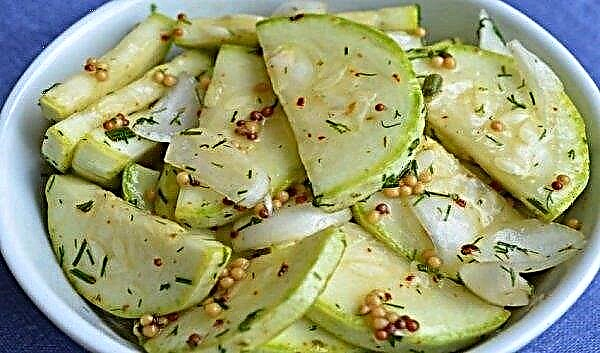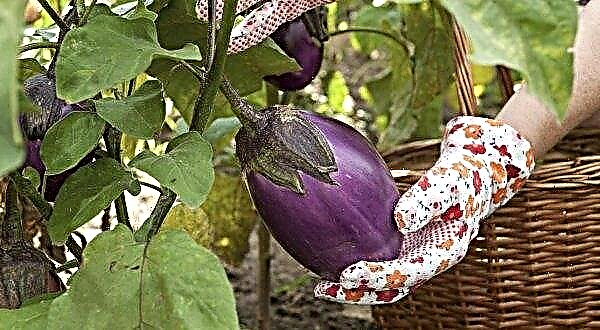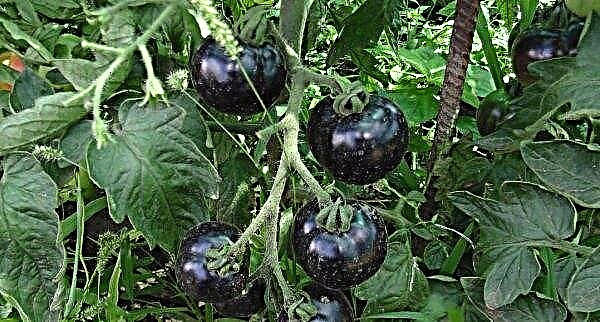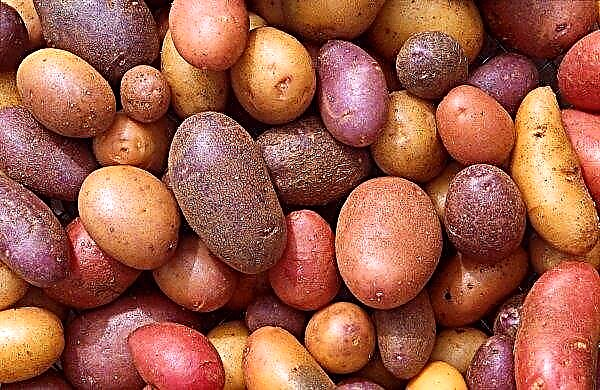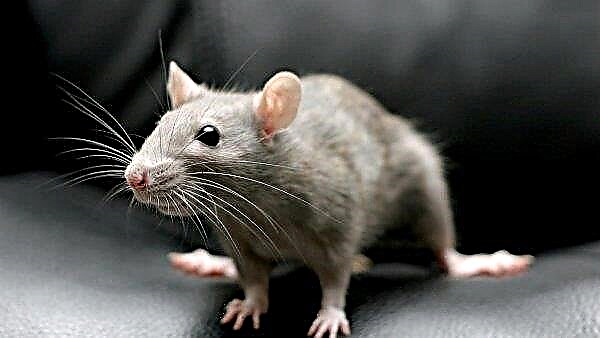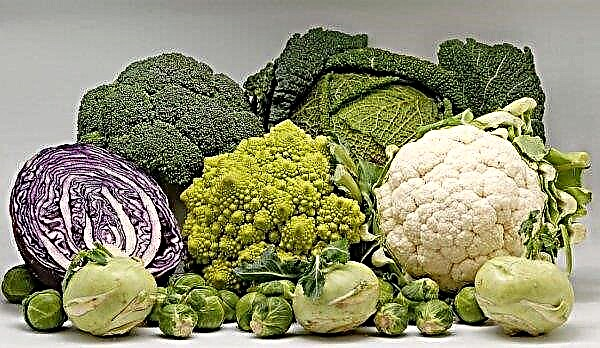Eggplant - very tasty and healthy vegetables, rich in solanine and healthy vitamins. When growing eggplants in a greenhouse, the grower may encounter such unpleasant phenomena as diseases and pests. In this article, we will examine how eggplants can hurt, what insects pose a danger to them, and how to deal with it.
External signs of disease
It often happens that, entering a greenhouse, a vegetable grower notices that everything is not okay with the eggplants, the bushes are yellow or stained, leaves and ovaries are crumbling, deformed, not stained or the fruits do not grow. The reason for this can be both fungal or bacterial diseases, and the invasion of pests. In order to take measures to improve the state of planting, you need to correctly and timely determine the diagnosis.
Did you know? A study published in 1993 in the English Medical Journal showed that among all vegetables, eggplant is in first place for the highest levels of nicotine. But this should not cause concern for the consumer, since you need to eat from 9 to 18 kg of eggplant in order to saturate the body with the amount of nicotine that a person receives by smoking one cigarette.
The main types of diseases
Many diseases can occur on eggplants, caused by insects that transmit the infection from bush to bush, as well as fungal or bacterial spores. The following are the most common diseases in eggplant culture.
Blackleg
This is the most dangerous disease for young eggplant. The spores of the fungus are in the soil, if the climate becomes favorable for it, then the fungus develops and moves to young bushes in the place where the border of land and air passes. Having settled on the stem, the fungus seals blood vessels and prevents the plant from receiving nutrients. The stalk near the ground becomes brown, dries out, thins out, in this place the constriction of the stalk is obtained. The stem of the eggplant in the place where the fungus is located breaks, the plant dies. How to get rid. At the first signs of the appearance of a fungus, the soil and plants should be treated with any antifungal drug, temporarily completely stop watering and feeding, carry out regular ventilation, raise the temperature in the room, improve lighting, dust leaves, stems and soil in the aisles with wood ash.
How to get rid. At the first signs of the appearance of a fungus, the soil and plants should be treated with any antifungal drug, temporarily completely stop watering and feeding, carry out regular ventilation, raise the temperature in the room, improve lighting, dust leaves, stems and soil in the aisles with wood ash.
Prevention Do not lower the temperature in the room where eggplant seedlings are grown below + 20 ° C, ventilate the room regularly. The first 20 days of seedling's life are watered very moderately and rarely. Provide seedlings with good lighting by installing a phytolamp next to the seedlings.
Did you know? The health benefits of eating eggplant include: strengthening bones and preventing osteoporosis, and reducing symptoms of anemia. Vegetable improves the health of the cardiovascular system and protects the digestive system, prevents the occurrence of cancer. Eggplant is also good for dropping weight, diabetes treatment, stress relief and in utero protection of the fetus from birth defects.
Late blight
Phytophthora sp. - the disease is caused by a fungus. The disease affects the leaves, stems and fruits, brown and black spots appear on them, followed by tissue necrosis. In the first stage, a whitish mycelium develops under the lower plate of eggplant leaves. The disease develops at a temperature of +10 ... + 25 ° C, in the presence of high humidity. How to get rid. At the first symptoms, fungicides are sprayed.
How to get rid. At the first symptoms, fungicides are sprayed.
Prevention Plants are fed with balanced fertilizers and maximally avoid high humidity in the greenhouse. Sterilization of the soil through heat treatment or irrigation of the soil with such an antifungal drug as Trichodermin is recommended. Conduct one or two preventive treatments on the sheet with copper-containing preparations.
Did you know? Eggplant — a reliable supplier of dietary fiber, vitamin B1 and copper. It is a good source of manganese, vitamin B6, niacin, potassium, folate and vitamin K. Eggplants also contain phytonutrients such as nazunin and chlorogenic acid.
Sclerotiniosis and Alternaria
Sclerotinia is a fungus that causes root and stem rot. Black growths (sclerotia) form in the roots of diseased eggplant, gray mold appears on the aerial part of the plant. Sclerotiniosis also causes rotting of the leaves - in case of serious infection, the entire aerial part may turn yellow and fall off the root system. The fungus can persist in the land for many years. An outbreak is caused by humidity and heat. How to get rid. Infected plants must be dug up together with the roots and destroyed on fire, the remaining eggplant plantings must be treated with a Bordeaux mixture or preparations with copper oxychlorides.
How to get rid. Infected plants must be dug up together with the roots and destroyed on fire, the remaining eggplant plantings must be treated with a Bordeaux mixture or preparations with copper oxychlorides.
Prevention In order to avoid the occurrence of sclerotiniosis in a greenhouse with eggplant, it is necessary to observe the time interval between growing a crop on the same bed (2-3 years), avoid stagnation of water, ventilate the greenhouse well, ensure that the plants are illuminated by sunlight, avoid contact of eggplant leaves with soil.
Did you know? 100 g of eggplant contains 25 calories. These vegetables are composed of 92% water, 6% carbohydrates, 1% protein and a small amount of fat.
Alternariosis - this disease is also known as "gray rot", caused by a fungus that remains in the soil, on the remains of infected plants and on infected seeds. Usually adult plants fall ill, dark brown irregular spots with yellow, rotting, and subsequently holey halo in the center appear on the leaves.
Black dead spots appear on the stem, mainly located near the branches. On the eggplant fruit, damage appears in the area of connection with the petiole in the form of a dark round spot intersected by deep folds. Sometimes inflorescences are also damaged, dead areas also appear on them. How to get rid. Tear up and take out infected plants from the site, in case of mass damage to the plants, treat the eggplants with preparations containing copper sulfate.
How to get rid. Tear up and take out infected plants from the site, in case of mass damage to the plants, treat the eggplants with preparations containing copper sulfate.
Prevention To combat alternariosis, it is recommended that crop rotation is observed with a time interval of at least 3 years, seed treatment in hot water. It is also recommended to avoid over-dense planting, excessive watering, stagnation of water in the soil and the use of incompletely decomposed organic fertilizers.
Internal necrosis
This viral disease leads to drying out and mummification of some parts of the eggplant fruit. How to get rid. This disease is easier to prevent at the seed stage than to fight it on adult plants.
How to get rid. This disease is easier to prevent at the seed stage than to fight it on adult plants.
Prevention Before sowing seeds into the soil for 20 minutes they are kept in a 20% hydrochloric acid solution for disinfection. After this time, the seed is washed in several waters, after which it is dried to flowability and sown. It is also desirable to disinfect (boil with boiling water or calcine in the oven) soil for growing eggplant seedlings.
Botritis
Botrytis is a fungal disease, it mainly develops with increased humidity and cool temperatures, in poorly ventilated rooms. It causes rotting on the stems and leaves, rotting spots subsequently covered with a characteristic grayish mold and die. How to get rid. This is a fungus that spreads rapidly, so it is very important to remove infected plants from the greenhouse and quickly treat the plantings with preparations containing copper oxychloride.
How to get rid. This is a fungus that spreads rapidly, so it is very important to remove infected plants from the greenhouse and quickly treat the plantings with preparations containing copper oxychloride.
Prevention It is recommended to avoid the use of incompletely decomposed compost or fresh manure, stagnant in the basal zone of water and excessive watering, and it is also impossible to fertilize the beds too much.
Tobacco mosaic
This is a very dangerous viral disease that spreads through insects (aphids, nematodes) or injuries sustained during planting care. It manifests itself in the appearance of characteristic discolored areas (yellow, light green, brown) on the leaves, and other symptoms of tobacco mosaic are also known: wilting, bent peaks, dwarf bush, low productivity. Fruits on infected plants are usually deformed or the plants do not bear fruit at all. The fruit has a wrinkled epidermis, necrotic areas of an elongated shape are present on the skin. How to get rid. There is no medicine for viral diseases, a diseased plant must be removed along with the roots from the garden and burned. The fight mainly consists in suppressing parasite vectors (in particular, aphids and nematodes) and eliminating the affected bushes.
How to get rid. There is no medicine for viral diseases, a diseased plant must be removed along with the roots from the garden and burned. The fight mainly consists in suppressing parasite vectors (in particular, aphids and nematodes) and eliminating the affected bushes.
Prevention The use of disinfected working tools, the use of virus-free planting material and mosaic-resistant eggplant varieties, the timely protection of plants from vector parasites.
The main types of pests
Eggplants are very vulnerable to the activity of insects sucking juice or eating their leaves. Insects such as aphids and spider mites not only deplete vegetables by eating their juice, but also transfer bacteria and fungal spores from plant to plant.
Aphid
These are small insects of green, gray or black color, sucking lymph from leaves and young shoots, which causes the deformation of plants. They are the main carriers of viral diseases. Aphid colonies are located on young shoots of eggplant, causing twisting and drying of leaves, root hypertrophy and inhibition of growth. How to get rid. Treat the bushes with insecticides or flush small pests with a strong pressure of water from a hose. To combat aphids, you can also use its natural predators, such as ladybugs or ground beetles.
How to get rid. Treat the bushes with insecticides or flush small pests with a strong pressure of water from a hose. To combat aphids, you can also use its natural predators, such as ladybugs or ground beetles.
Prevention Prevent the formation of an anthill next to the greenhouse, cover the eggplant bed with mulch, and feed the plants with balanced fertilizers with a low nitrogen content. It is also advisable to avoid using cold water for irrigation.
Spider mite
Panonychus ulmi or red spider mite. Before reaching adulthood, the pest has transparent chitin, so it is very difficult to notice on plants, adult insects have a red or burgundy color. It affects eggplant, located on the underside of the leaves and sucks the juice. Most often, it attacks leaves, but also likes to eat young stems, which causes the appearance of deformed leaves. Affected leaves subsequently turn yellow, often showered. Symptoms caused by the attack of the red spider mite are a decrease in photosynthetic activity, yellowing of the leaves. How to get rid. The bushes are treated with insecticides, the spider mite is washed off with high pressure jets of water, and the leaves and stems are washed with soapy water.
How to get rid. The bushes are treated with insecticides, the spider mite is washed off with high pressure jets of water, and the leaves and stems are washed with soapy water.
Prevention They limit the nutrition of greenhouse eggplants with fertilizers with a high nitrogen content, maintain a high temperature in the greenhouse, and reduce air humidity.
Whitefly
Trialeurodes vaporarium or whitefly - a small fly with milky-white wings, loves moist and warm greenhouse air, is located on the underside of the leaves, where it eats juice. The suction of the juice, along with the abundant production of honey dew, contributes to the development of harmful fungi, causes yellowing of the leaf plate, leads to inhibition of growth and, in extreme cases, to the death of eggplant. Whitefly develops up to 5 generations during the warm season. A hot and humid climate, combined with a lack of ventilation, contributes to its appearance on eggplant planting, so these insects breed continuously in a heated greenhouse with a slowdown in reproduction in the winter. How to get rid. The fight consists in spraying plantings with insecticides or tansy infusion, using biological or glue traps.
How to get rid. The fight consists in spraying plantings with insecticides or tansy infusion, using biological or glue traps.
Prevention Reduce the number of irrigation in greenhouse structures and maintain soil moisture by mulching the soil, regularly ventilate the greenhouse.
Ways to control pests and diseases
Eggplant pests can cause serious damage to the quantity and quality of the crop, and if it was not possible to prevent this invasion through preventive measures, it is time for the grower to begin to destroy them.
Important! It is not recommended to exceed the dosage of the chemical specified in the instructions. It is not safe for human health and may cause unwanted effects.
Processing plantings of eggplant in a greenhouse with pesticides:
- To do this, spraying plants on the sheet with insecticides ("Karate", "Intavir", "Aktara", "Actellik") is used.
- Eggplant leaves are sprayed from a garden pump spray gun, chemicals are diluted with water in the proportions specified in the instructions attached to the substance. The resulting solution must be filtered, so that the solid particles do not clog the sprayer. Experienced gardeners recommend adding liquid soap or dishwashing detergent (for sticking) to any solution when spraying.
- Spraying is carried out in the afternoon, after 16 hours. At this time, the midday heat is already starting to decline, and this is important, since most chemicals are not recommended for use at temperatures above + 25 ° C. In the morning or lunch time, such treatments can be carried out on a cloudy or cool day.
- The person conducting the chemical treatment must be dressed in clothes that completely cover the body, gloves, headgear and glasses to avoid contact with the skin. During the chemical treatment of plants, a working person should not drink water, eat or smoke in order to prevent the chemical product from getting on the mucous membrane of the mouth. At the end of the work, clothes are washed with soap, and a person visits the shower.
 The eggplant bushes, slightly populated by aphids and spider mites, can be tried to free from pests by washing them with a jet of high-pressure water from a garden hose. This method can lead to success, but simultaneously with the destruction of aphids, the grower needs to fight against ants that bring aphids to eggplant. Ants are destroyed by laying out poisonous bait along the beds in the greenhouse and next to the anthill.
The eggplant bushes, slightly populated by aphids and spider mites, can be tried to free from pests by washing them with a jet of high-pressure water from a garden hose. This method can lead to success, but simultaneously with the destruction of aphids, the grower needs to fight against ants that bring aphids to eggplant. Ants are destroyed by laying out poisonous bait along the beds in the greenhouse and next to the anthill.Important! As fertilizers for future planting of eggplant, you can use the planting of siderates from the legume family, which saturate the soil with nitrogen and improve the soil structure.
Preventive measures
In order to prevent eggplant diseases in the greenhouse, the following rules must be observed:
- Follow the planting scheme, do not allow excessive planting densification in the garden.
- Use a secateurs to remove the lower leaves in contact with the ground.
- On adult eggplants, thinning is necessary to remove excess stepsons and leaves.
- Conduct preventive foliar treatments with chemical or biological agents for diseases and harmful insects.
- Run insects, natural predators aphids, whiteflies and other pests (ladybug, ground beetle) into the greenhouse.
- Observe crop rotation by returning plants of the same family to the greenhouse no earlier than 3 years later.
- Carry out sterilization of the greenhouse and soil at the end of the growing season.
- Treat leaves with biological products: infusion of garlic, nettle. It is also very effective to spray the bushes with pyrethrum and a soap solution.
- To grow plants emitting volatile products in a greenhouse: dill, fennel, marigolds, nasturtium, calendula. These plants attract other insects into the greenhouse, which are natural predators for pests.
 Of the biological methods for protecting eggplant, you can use garlic. The pulp of the bulb of this plant has bactericidal qualities and has a strong, stable odor. Ticks, aphids and other insect pests do not like this smell. Also, garlic is effective against fungal diseases and, if the soil is watered with a garlic solution, against some types of parasites that live in the soil.
Of the biological methods for protecting eggplant, you can use garlic. The pulp of the bulb of this plant has bactericidal qualities and has a strong, stable odor. Ticks, aphids and other insect pests do not like this smell. Also, garlic is effective against fungal diseases and, if the soil is watered with a garlic solution, against some types of parasites that live in the soil.It must be remembered that the biological product does not have the speed of the chemical repellent, and if the greenhouse is already infected with pests and diseases, it is unlikely that the garlic can provide effective help, but in the preventive phase or at the beginning of the problem, garlic works perfectly.
Important! After the eggplants have been sprayed with protective chemicals, their fruits are not suitable for consumption over the next 14 days.
Cooking garlic infusion:
- Using garlic presses, grind 3-4 cloves of garlic and pour 0.5 liters of hot water.
- After this, the solution is left for a couple of hours until naturally cooled.
- If you need to prepare a large amount of garlic water for introduction into the root zone of plants, you can use both bulbs and garlic leaves at the rate of 5 kg of fresh plants per 100 liters of water.
Disease resistant varieties
There are many varieties of eggplant, not bad resistance to pathogens. Why not gardeners choose such varieties in order to avoid problems with the treatment of diseases when growing.
Disease-resistant eggplant varieties:
Eggplants are heat-loving plants, so in our country, for the most part, this vegetable is grown indoors. A plant grower will get a rich harvest of delicious purple vegetables if he can provide his plants with protection against diseases and harmful insects.


